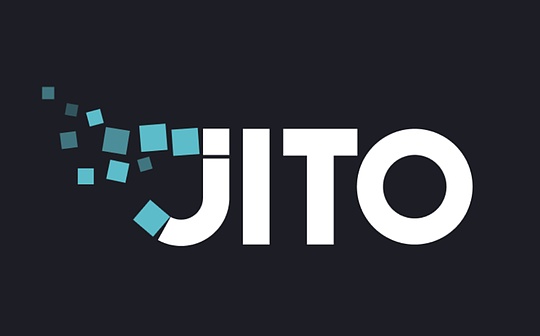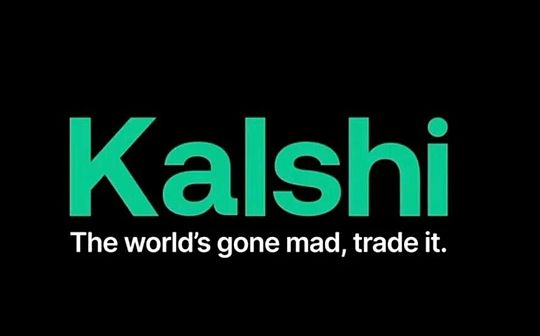
Author: Christine Kim Source: Galaxy Translation: Shan Oppa, Bitchain Vision
Summary
This report provides a comprehensive overview of staking, how staking works on Ethereum, and important considerations for stakeholders when participating in this activity.This is the first part of a three-part report series that will dig into the risks and rewards of a variety of staking activities, including restaking and liquidity restaking.The second report in the series will outline restaking, how pledges work on Ethereum and Cosmos, and the important risks associated with restaking.
introduce
Ethereum is the largest proof of stake (PoS) blockchain calculated by total stake value.As of July 15, 2024, ETH holders have pledged Ethereum (ETH) worth more than US$111 billion, accounting for 28% of the total ETH supply.The amount of ETH staking is also called Ethereum’s “security budget” because these assets may be penalized by the network in the event of double payment attacks and other violations of protocol rules.As a contribution to Ethereum security, users who stake ETH will receive rewards through protocol issuance, priority tips, and maximum extractable value (MEV).Users can easily stake ETH through a liquid staking pool without sacrificing liquidity of assets, which results in higher demand for staking than expected by Ethereum protocol developers.Based on current staking dynamics, developers expect the total supply of ETH (also known as staking ratio) to be staking will only grow higher in the coming years.To mitigate this trend, developers are considering major changes to the agreement’s issuance policy.
This report will outline the staking on Ethereum, including the types of staking users on Ethereum, the risks and returns of staking, and the forecast of staking rates.The report will also provide insights into developers’ proposals to change network issuance to curb staking demand.
Types of equity holders
There are six main types of Ethereum users who can receive rewards through staking.The following table details their respective profiles:
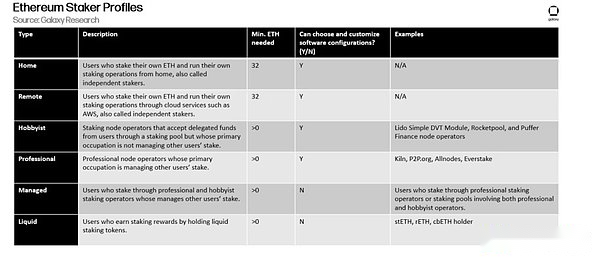
Among these major types of stakers, the largest number are custodian stakers, i.e. those who entrust ETH to professional stake node operators.Although professional pledge node operators are not as large as their customer base, they are the type of pledge entities with the largest number of pledge ETHs managed.
This analysis does not include liquidity staking, restaking, and liquidity restaking pool agreements, as these entities do not directly run the staking infrastructure or provide funding for their use.However, these entities do receive a percentage of returns from professional (or amateur) stakers who use their platform to provide services to custodian stakers; they are middlemen who promote relationships between custodian stakers and professional (or amateur) stakers;Entities, therefore, are important participants in the Ethereum staking industry.Lido is a liquid staking agreement, by far the largest staking pool operator on Ethereum, through which approximately 29% of the total staking ETH is entrusted to professional and amateur stakingers.Given the adoption and key role of liquid staking pools on Ethereum, it is important to understand the risks of liquid staking.

The next section of this report will explore the risks of staking based on the technologies and entities used to receive staking rewards.
Pledge risk
The risks associated with pledge depend heavily on the methods and techniques of pledge.Here are three categories that define staking methods and their associated risks:
-
Direct pledge: Pledge refers to the user or entity operating its proprietary pledge hardware and software.The risks of direct pledging ETH include pledge punishment and reduction risks.Pledge punishment caused by long-term machine shutdowns and other reasons may cause users to lose some of the pledge rewards.Cut events caused by misconfiguration of validator software, etc., may cause the user to lose part of the pledged ETH balance, up to 1 ETH.
-
Entrusted pledge: Pledge refers to the user or entity entrusting its ETH to professional or amateur pledgeers for pledge.The risk of delegating ETH to another entity to pledge you includes all risks of direct pledge, and there is also counterparty risk, because the entity you entrusts to pledge may not fulfill its responsibilities or obligations as a pledge service.ETH holders can delegate their stake to stake-as-a-service entities with trust minimized, such as entities that are primarily controlled through smart contract code, but this brings additional technical risks as the code can be hacked or contains errors.
-
Liquidity pledge: Pledge refers to the user or entity entrusts professional or amateur pledges to pledge them and exchange them for liquid tokens that represent them pledge ETH.The risk of liquid staking includes all risks of direct staking and entrusted staking, but in addition, due to market volatility and long-term delays in entry or exit of validators, liquidity risks may lead to decoupling events where the value of liquid staking tokens is in line with the underlying stakingThe value of the asset is significantly deviated.
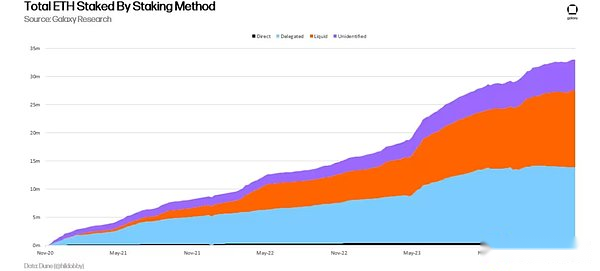
Another risk that needs to be emphasized for these three types of pledge activities is regulatory risk.The further distance the ETH holder is from his pledged assets, the greater the regulatory risk of pledge activities.Delegated and liquid staking requirements ETH holders rely on different types of intermediary entities.In the view of lawmakers and regulators, these entities may need to comply with certain rules and regulatory frameworks to operate, depending on their structure and business model, such as AML/KYC measures and securities laws.
In addition to regulatory risks, it is worth specifying the exact agreement risks associated with these three types of staking activities.Protocol risks stem from the penalty that the network can automatically incur for user staking intentionally or unintentionally for not meeting the standards and rules detailed in the Ethereum Consensus Agreement.There are three main types of punishment.Sort by severity from low to high, they are:
-
Offline punishment: Punishment when a node is offline and fails to perform its duties (such as proposing a block or signing a block proof).Generally speaking, validators will be punished only a few dollars a day.
-
Initial cuts penalty: Punishment for any validator behavior that other validators detect that violates network rules.The most common example is if the verifier proposes two blocks for a time slot or signs two proofs for the same block.The penalty ranges from 0.5 ETH to 1 ETH depending on the validator’s valid balance, currently up to 32 ETH.Protocol developers are currently considering increasing the validator’s maximum effective balance to 2048 ETH and reducing the initial cut penalty in the next network-wide upgrade Pectra.
-
Related penalty reduction: After the initial cut penalty, the validator may be penalized for a second time based on the total amount of pledges cut within 18 days before and after the cut event.The motivation for the relevant penalties is to measure penalties based on the amount of pledges managed by validators identified as violating network rules.The relevant penalties are calculated based on the sum of the valid balance, total balance and proportional cut multiplier 3 of the malicious validator.
In addition to the above three punishments, if the network cannot achieve the final result, special punishment can be imposed on the verifier.For a detailed overview of Ethereum’s final results, see this Galaxy Research report.When the network cannot be finalized, it imposes increasingly greater penalties on offline validators.By gradually destroying stakes in validators who have not contributed to the network consensus, the network can rebalance the validator set to achieve the final result.The longer the network cannot achieve the final result, the greater the severity of the punishment.
Pledge Reward
In exchange for the risks mentioned above, the pledger can earn an annualized return of approximately 4% from the ETH deposits he pledged.Rewards come from new ETH issuances, priority tips attached by Ethereum end users to their transactions, and MEV (extra value from within-block user transaction reordering).
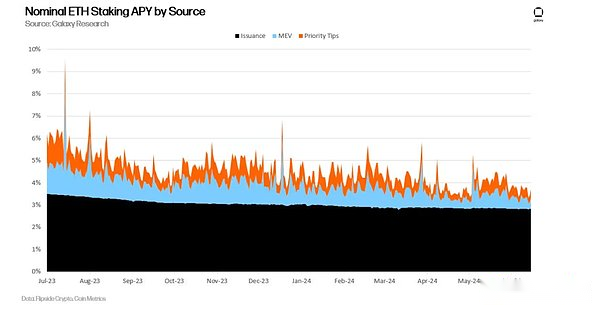
Please note that stakers’ rewards have been steadily declining over the past 2 years.There are two main reasons for this.First, the total number of pledged ETH and the number of validators increased during the same period.As the value of the stake increases, the validator’s issuance reward is diluted among more participants, as shown in the figure below:
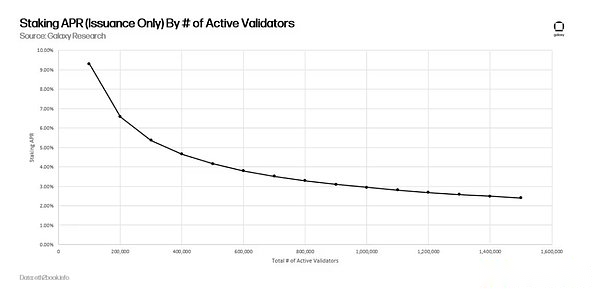
While issuance rewards can be calculated based on the total number of active validators and the staking ETH supply on Ethereum, two other sources of revenue for validators are less predictable because they rely on online transaction activity.
Trading activity has decreased over the past two years, resulting in a decrease in base fees, priority tips and MEVs for validators.Generally, the higher the value of assets transferred on-chain, the higher the tip the user is willing to pay to prioritize these transactions in the next block, and the higher the MEV the searcher profits from reordering within the block.As shown in the figure below, the value of the daily transfer of USD is related to the average transaction priority fee:
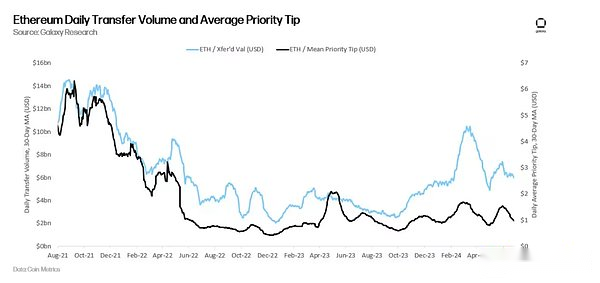
According to Galaxy’s calculations, when the reward is calculated as an annual percentage rate of return, the MEV can increase the validator reward by about 1.2%.The proportion of validator rewards from MEVs is about 20% compared to other types of validator revenues, including issuance and priority tips.Some attribute MEV to the additional value granted to block proposers, which does not come from priority tips or issuances, which is the method represented by the charts ahead of this report.However, others believe that if the high priority tip is obtained through successful preemptive or reverse transactions, the high priority tip transaction itself can represent the MEV profit.To explain the fact that priority tips themselves may contain MEVs, other methods compare the value of blocks built with MEV-Boost software and blocks not built with MEV-Boost software.
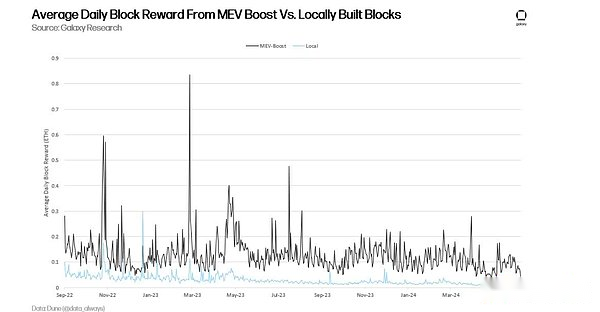
These methods (as shown in the figure above) suggest that the size of the MEV may be much larger than the validator’s reward.According to an October 2023 analysis by Ethereum Foundation researcher Toni Wahrstätter, the median block reward will increase by 400% if validators receive blocks through MEV-Boost instead of building blocks locally.
For more information on the impact of MEV on the validator economy, read the Galaxy Research report on MEV-Boost.
Pledge Rate Forecast
Assuming that staking demand on Ethereum has grown linearly as in the past two years, the staking rate is expected to exceed 30% in 2024.As mentioned earlier in this report, a higher staking rate will reduce issuance returns.Mobile staking services on Ethereum allow users to easily stake and bypass normal restrictions on staking such as entry queues.Users only need to purchase stETH to get a pledge return.Buying stETH in large quantities will result in an imbalance in the value of stETH in the open market with the value of the underlying staking assets, which will result in a premium of stETH value until more ETH is pledged on Ethereum.Unlike buying stETH, staking activity on Ethereum will be delayed.Each epoch (i.e. 6.4 minutes) can only add 8 new validators or a valid balance of up to 256 ETH to Ethereum.So, assuming that the number of validator entries reaches its maximum for each period from now until the end of 2025, it will take more than a year (466 days to be exact) to reach 50% of the total ETH supply.
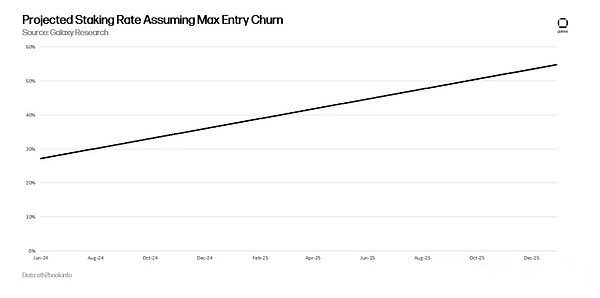
Historically, the demand for entering the Ethereum staking queue is higher than the demand for exit.Despite the decline in validators’ activity into queues in recent days, pledge demand is expected to soar again for a variety of reasons, including but not limited to additional benefits through restaking, increased MEV from the recovery of DeFi activity, and support for transactionsRegulatory changes in pledge activities in traditional financial products such as traded funds.
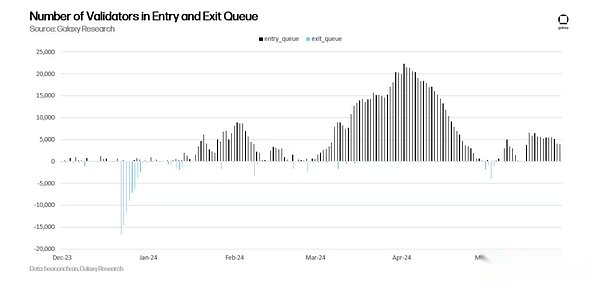
Developers know that it is only a matter of time before the staking rate rises again and the stakinger revenues fall, so they are considering several options to change the network issuance to curb staking demand.
Discussion on release changes
ETH holders should expect that the pledge yield will change dramatically in the future.Protocol developers are weighing options to ensure Ethereum’s staking rate tends toward target thresholds, such as 25% or 12.5%.Caspar Schwarz Schilling, an Ethereum Foundation researcher, explained that the main reasons for maintaining low stake rates include:
-
Liquid Staking Token (LST) Dominance: If the staking rate increases, the amount of ETH concentrated in a staking pool (such as Lido) may increase, causing the risk of centralization of an entity or smart contract application and having an excessive impact on Ethereum securityrisk.
-
The credibility of cuts: Related to concerns about LST dominance, the merger of high circulation into a single entity or smart contract application may reduce the credibility of massive cuts on Ethereum.For example, if a cut incident affecting most stakeholders occurs, the agreement may face social pressure from ETH holders who want the organization to change its status from time to time to restore the penalized staked ETH balance.Ethereum protocol developers have only organized once in the network history of irregular status changes, with the goal of restoring user funds after a smart contract error occurs.That came after the infamous DAO hack in 2016.(Read more about DAO hacking incidents in this Galaxy Research report.) While unlikely, it is not impossible to make irregular state changes in response to massive cuts.In fact, some Ethereum researchers believe that such results are more likely to occur in high circulation situations.
-
Ensure no trust-free base currency: Also related to concerns about LST dominance, high circulation could lead to insufficient native ETH in circulation, and a surge in native ETH tokens issued by third-party entities.Ethereum researchers say they tend to promote use cases other than pure staking using native ETH so that end users don’t have to rely on using on-chain currencies issued by relatively less centralized and trusted applications, while ETH is by EthereumAgreement issuance.
-
Minimum Viable Issuance (MVI):Although the pledge cost is insignificant compared to the mining cost, the pledge cost cannot be ignored.Professional staking providers need the hardware and software needed to run the validator, so they need to pay for the operating costs.To be pledged through these providers, users must pay fees to these providers.In addition, even if users obtain liquid pledged tokens by staking native ETH, if the staking operation fails, they will bear additional risks and fines for staking through third parties.Therefore, it is in the interest of the network to keep the staking cost to the minimum level, as the additional cost of supporting staking activities means higher issuances, resulting in an expansion of ETH supply.
Ethereum protocol developers and researchers are weighing various proposals to reduce Ethereum staking rates.These proposals include, but are not limited to:
-
Short-term one-time cuts:In February 2024, Ethereum Foundation researchers Ansgar Dietrichs and Caspar Schwarz-Schilling once again proposed a one-time reduction in staking yields.The idea was originally proposed by Anders Elowsson, a researcher at the Ethereum Foundation.In the latest article by Dietrichs and Schilling, researchers recommend cutting staking yields by 30%.However, this number depends on the staking rate of Ethereum, i.e. the total supply of ETH staking.Given that pledge rates have been rising since February, researchers believe that the theoretically recommended yield cuts should be higher.The proposal does not guarantee the upper limit of pledge requirements, but only simple code changes are required to be implemented, and will curb the economic incentives for pledge by reducing short-term issuance rewards.The proposal is intended as a temporary measure to pave the way for long-term solutions such as target policies.
-
In the long run, the pledge ratio target: Implement a new issuance curve, the higher the staking rate exceeds the target ratio (e.g. 25% of the total supply of ETH pledged), the higher the cost of validators pledging and receiving rewards.This idea is based on research by Elowsson, Dietrichs, and Schwartz-Schilling.There are several mechanisms that can achieve target ratios, each varying in the issuance schedule and the severity of the decline in circulation.For more details on the issuance curve under the staking ratio target model, read this Ethereum research article.
All of the above proposals will not be included in the next Ethereum hard fork Pectra.However, there is a high probability that protocol developers will push for changes to releases in subsequent upgrades.So far, discussions on issuance changes within the Ethereum community have been very controversial and no broad consensus has been reached.Key objections to the issuance changes include concerns that a decrease in staking revenue will harm the profitability of large staking providers operating on Ethereum and individual and at-home stakers.Users also object to the lack of sufficient research and data-driven analysis for proposals that have affected issuance to date.It is unclear what the exact target stake ratio should be for achieving MVI, and whether achieving this through issuance changes will reduce concerns about centralized stake distributions, or whether it will exacerbate the problem by further preventing the participation of individual stakeholders.To address some concerns about the long-term profitability of individual stakeholders on Ethereum, Ethereum co-founder Vitalik Buterin shared a preliminary study in March 2024, with the addition of new anti-related rewards and penalties to haveHelps control node operators with fewer validators.
Ethereum’s Proof of Stake blockchain beacon chain has not changed since its birth in December 2020.However, Ethereum’s monetary policy did undergo several revisions in its approximately seven-year history before its merger with the beacon chain.The reward for mining a block on Ethereum is initially set to 5 ETH/block.In the September 2017 Metropolitan upgrade, it was reduced to 3 ETH .Then in the February 2019 Constantinople upgrade, it dropped to 2 ETH again.The miners then saw the rewards they received from transaction fees burned in the London upgrade in August 2021, and then the mining rewards were completely abolished on the network during the merger upgrade in September 2022.
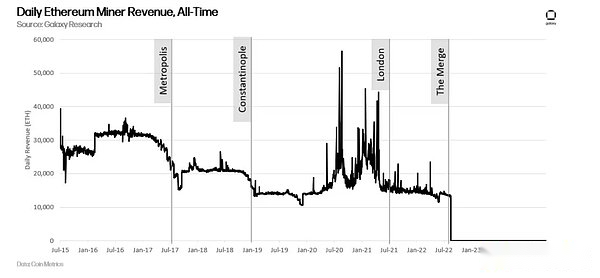
Under the Proof of Stake Consensus Agreement, changes in Ethereum monetary policy may be more controversial than previous changes issued online under Proof of Work, as the user base is affected by the change is much wider.Unlike strict miners, issuance changes affect an increasing number of ETH holders, stake-as-a-service providers, liquid stake-token issuers, and restake-token issuers.As the stakeholder base involved in protecting Ethereum is growing, it is unlikely that Ethereum protocol developers will change Ethereum’s monetary policy as frequently as they did in the past.The controversial nature of this discussion may lead to increasingly rigid policies and rewards related to pledges over time.Therefore, as the staking industry built on Ethereum develops and matures, the window of opportunity to change the Ethereum code base is shrinking and unlikely to last for a long time.
in conclusion
The staking economy built on Ethereum is still in its infancy and experimental stage.When the beacon chain was first launched in 2020, users who stake ETH could not guarantee that they would withdraw ETH or transfer funds back to Ethereum.When the beacon chain merges with Ethereum in 2022, users receive additional rewards for staking through tips and MEVs.When the staking ETH extraction function is enabled in 2023, users can finally exit the verifier and profit from the staking operation.There are a series of other changes coming on the Ethereum development roadmap that will affect the staking business and individual, at-home stakers operating on Ethereum.While most of these changes will not affect the economic incentives of staking, such as increasing the maximum valid balance of validators in Pectra, some will.Therefore, as Ethereum’s development roadmap continues to evolve and is implemented through hard forks, it is important to carefully evaluate the risks and returns of staking on Ethereum.Since Ethereum’s staking economy covers more stakeholders than Ethereum’s once mining industry, frequent changes that affect staking dynamics over time may make it more difficult for Ethereum protocol developers to execute.Yet Ethereum remains a relatively new proof-of-stake blockchain, with significant changes expected in the coming months and years, prompting a careful consideration to change the stake dynamics of all relevant stakeholders.

